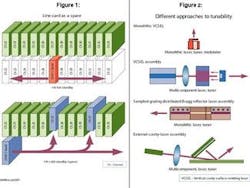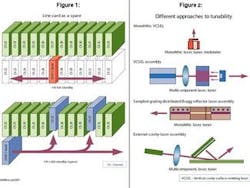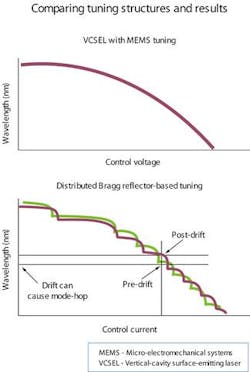Usable tunability for metro networks
Figure 1. One tunable-laser line card can serve as a spare for multiple wavelengths.
Figure 2. Structurally, sampled-grating distributed Bragg reflector (SGDBR) lasers, external-cavity lasers (ECLs), and vertical-cavity surface-emitting lasers (VCSELs) use very different approaches to tunability, resulting in devices of different size, cost, and complexity.
Tunable lasers promise more service flexibility and profitability for network service providers, creating a market of more than $2.3 billion by 2005, according to the Yankee Group. By offering remote, dynamic-wavelength control, tunable lasers will make optical networks more efficient, more responsive to customer needs, and significantly less expensive to operate.
Tunable lasers are being evaluated for deployment in long-haul (LH) networks to reduce the cost of sparing, but the real promise of dynamic-wavelength tuning will blossom in metropolitan markets. A closer examination of the characteristics of the various tunable-laser technologies offers some insight into how these different approaches stack up as solutions for metro carriers' network requirements.
Benefits of tunable lasers
With the rise of DWDM systems for optical transport, wavelength tunability offers carriers a solution to fundamental cost and network optimization problems posed by fixed-wavelength lasers. Tunability provides a number of advantages, chief of which is its wavelength flexibility. A non-tunable 32-channel DWDM system for LH networks requires 32 fixed-wavelength lasers, each configured to a particular wavelength. In typical metropolitan systems, there are 32 working lasers and 32 protect lasers since metro DWDM systems are typically providing SONET-like protection. Since configurations seldom change between cities and between major carrier points of presence in LH networks, wavelength flexibility is not as important as it is in the metro area, but it can still offer significant benefits to users: Network operators do not have to stock as many spares; manufacturers can reduce their inventories of DWDM systems.
Line cards break so carriers must maintain large inventories of backup line cards, which are preconfigured with dedicated lasers for each of the wavelengths in service. A 32-channel system requires at least 16 backup line cards, one for each wavelength. Often, carriers, or their suppliers, inventory two backup line cards for each channel in service: one for transmit and one for receive.
DWDM systems in a LH network may be located hundreds of miles away from the nearest service center. Although DWDM systems in a metro network are located closer to service centers, many system nodes are not located in manned central offices. As a result, replacing a failed line card can mean rolling a truck to physically replace it. That is the logistical challenge when typical meantime-to-repair metrics are two hours.
Tunable lasers make it much easier to manage the challenges of maintaining spare inventories to replace failed line cards. With lasers that can tune to any of the wavelengths in service, carriers or their suppliers no longer have to maintain a one-to-one replacement inventory. Rather than needing 40 or more fixed-wavelength lasers as spares, DWDM systems can be reasonably supported with five lasers or less. As DWDM systems evolve to support more and more wavelengths and as the number of DWDM systems increases within a service center's area, the spare parts counts will be reduced and thus inventory savings will grow.
Fixed-wavelength devices require a 1:1 match between work and protect sources, while systems based on tunable sources can be designed to the reliability specification of interest. The remote configuration capabilities of tunable lasers make it possible to replace failed lasers remotely by incorporating tunable "hot standby" spares within a DWDM system. Having a tunable laser built into the system allows carriers to remotely replace a line-card failure within microseconds, dramatically reducing downtime as well as the operational cost of a truck roll (see Figure 1).
Tunability in the metro
In metro networks, the sparing and inventory benefits carry over from LH environments, but the rapid remote tuning capabilities of tunable lasers become even more valuable. Unlike LH networks, metro networks have thousands of end points that serve a rapidly growing and changing mix of customers and services. In this fast-changing environment, flexibility, deployment velocity, and cost control are critical advantages, and tunable lasers give carriers a number of competitive advantages.
In most metro areas, carriers compete on the basis of customer service, so faster provisioning through tunable lasers will give carriers a new way to provide quality customer service. Rather than forcing a new customer to wait weeks for new or improved service, carriers deploying remotely tunable DWDM platforms can provision those services within hours.
To meet the needs of a diverse customer base, many metro carriers must support a wide range of services, from OC-3 (155-Mbit/sec) to OC-48 (2.5-Gbit/sec) SONET to packet over SONET and Gigabit Ethernet and more, such as SANs. With the ability to dynamically reassign wavelengths, carriers can quickly retune DWDM systems to support different services. Near the network edge where there are many more users (each potentially leveraging different services and protocols), a network with tunable lasers, which can potentially support the array of services transparently and where the system capacity can be quickly reassigned to changing customer demographics, allows the metro carrier to generate more service revenue.
The path to profitability in networks is to use as much capacity as possible as much of the time as possible. Traffic patterns in today's data-centric metro networks fluctuate significantly; most services do not use all of a wavelength's bandwidth all the time. The bandwidth of fixed-wavelength metro DWDM systems is thus greatly underutilized in many cases. Tunable transmitters, on the other hand, are flexible enough to deal with changing demand, enabling network planners to dynamically re-provision wavelengths to make the most efficient use of available bandwidth.
Today, for example, a carrier may overbuild its fixed-wavelength system to meet peak network demand. If the carrier employed shared tunable lasers to supply the excess bandwidth that users need during peak demand periods, then it would require fewer lasers, and its networks would be smaller and less expensive to build and maintain.
In the current economic climate, carriers are reluctant to add new technology to their networks unless there is a rapid and fairly dramatic return on investment. By reducing sparing and inventory costs, supercharging service deployment velocity, and reducing truck rolls during provisioning and re-provisioning, tunable networks increase revenues, reduce costs, and improve operational efficiency. Replacing fixed-wavelength lasers with tunable lasers, even at prices that are more than 50% higher, can result in millions of dollars in savings for a single network. These savings grow as carriers add more channels and nodes and reduce the number of spares these channels and nodes require.
Metro requirements
By definition, any tunable laser supports multiple wavelengths, but simply doing so does not necessarily meet metro carrier requirements. To enhance profits and reduce operating costs, metro carriers need lasers that offer usable tunability. Each of the fundamental tunable-laser technologies offers a different level of usable tunability for the metro, as measured by the following characteristics:
• Power. Output power has historically been very important in lasers destined for the LH market, because the farther the laser transmits a signal, the less amplification or regeneration is required. Tunable-laser power outputs range from less than 1 mW up to 20 mW, and in LH applications, more power is typically better. But in metro applications where distances are 100 km or less, high output power is far less important, and in fact may be a handicap. Because of the large number of endpoints and optical add/drop multiplexers in a typical metro network, signal attenuation is a reality, and today's metro networks are designed with amplification technology to compensate for signal loss and meet the power requirements of high data rates on multiple wavelengths. Realistically, a tunable laser requires only enough power to reach the first amplification point, and some DWDM equipment vendors are now designing shared amplification into their systems to boost output power in a cost-effective way.
• Modulation rate. In LH networks, the higher the modulation rate, the better. Vendors of LH lasers and other components already offer OC-192 (9.95-Gbit/sec) modulation and are looking ahead to OC-768 (39.8 Gbits/sec) over the next couple of years. In the metro, however, most traffic is still in the OC-3-to-OC-48 (2.49-Gbit/sec) range. Thus, carriers expect that OC-48 modulation will be more than adequate for any equipment deployed within the coming year. To address the diverse needs of metro customers, a laser needs to support multiple data rates, up to and including OC-48.
Tunable-laser technologies
All tunable lasers incorporate semiconductor devices that operate by allowing users to change the wavelength of light produced. There are several approaches to achieving this tunability, and each has pros and cons. Essentially, there are two basic types of lasers: edge-emitters, such as sampled-grating distributed Bragg reflector (SGDBR) lasers and external-cavity lasers (ECLs), and vertical-cavity surface-emitting lasers (VCSELs). In edge-emitting lasers, the laser cavity is horizontal to the plane of the semiconductor, and light is emitted from semiconductor's edge. In VCSELs, the laser cavity runs vertically through the semiconductor material, and light is emitted from the top of the semiconductor.
SGDBR lasers are an evolution of the distributed Bragg reflector lasers used for years in LH networks. These devices employ two grating reflectors at the ends of a horizontal cavity. The two gratings have comb-like reflectivity. Controlling the currents to the reflectors shifts the spectral combs, which results in tuning. Although these lasers offer higher power than other solutions, wavelength tuning is difficult and complex.
ECLs are the least integrated tunable structures. In these devices, the laser output is incident to an external cavity containing an optical grating. The grating is angle-tuned by a mechanical actuator. By carefully aligning the relative positions of the laser and the grating, continuous-wavelength tuning can be obtained. Alternatively, a fixed grating with a micro-electromechanical systems (MEMS)-based mirror can be used to accomplish the same goal. ECLs offer good power performance, but due to the small dimension of the laser active region (0.1-0.3 micron) compared to the external cavity (∼1-30 cm), ECLs are sensitive to alignment, external optical feedback, and longitudinal mode competition.
VCSELs emit light from their surfaces, rather than their edges. The emission wavelength of a MEMS-assisted VCSEL can be tuned continuously by moving its top mirror (in part or whole) relative to its active region. One type of monolithically grown VCSEL integrates part of its top mirror with a MEMS structure to achieve a wide and continuous tuning range. Not all VCSELs are monolithically grown; for example, one type of VCSEL can be pumped by a second VCSEL or an ECL. This approach requires a complex tuning system and lower precision. Figure 2 shows the three types of laser structures.
How they measure up
In addition to the clear differences in structure between SGDBR lasers, ECLs, and VCSELs, each approach has strengths and weaknesses in terms of meeting the requirements of metro tunability.
SGDBR lasers and ECLs offer higher output power than VCSELs, largely because their designs were adapted from those of LH lasers, in which high power was an important consideration for spanning network segments measured in hundreds of kilometers. These lasers typically boast output power in the 10-20-mW range. However, metro-network planners now build-in signal amplification to compensate for signal loss at the many add/drop multiplexers and meet the power requirements of high data rates on multiple wavelengths. Therefore, lasers need only as much output power as required to reach the first amplification point, allowing for the use of tunable lasers that output only a fraction of a milliwatt.
Vendors of SGDBR lasers and ECLs have already announced plans to support OC-192 modulation rates. While that is important for LH markets, it does not address the majority of the metro market's needs; it results in the use of products that are more expensive than necessary for the job at hand. Both SGDBR lasers and ECLs use external modulators, which can add as much as $1,500 to the cost of building a tunable transmitter solution. In contrast, some VCSELs incorporate direct OC-48 modulation within a monolithic VSCEL structure, so designers need not integrate separate modulators.
SGDBR lasers and ECLs rely on multiple inputs in order to tune. SGDBR lasers use a pair of grating reflectors at opposite ends of the device to tune to a particular wavelength. ECLs focus a laser's output onto a waveguide grating, which reflects against a MEMS-actuated mirror, whose angle must be adjusted in two dimensions to produce a specific wavelength. Some VCSELs, on the other hand, use a single MEMS-actuated mirror adjusted in one dimension to change the length of the vertical cavity. As a result, these VCSELs require only one tuning control. Because SGDBR lasers and many ECLs employ multicontrol tuning, they may not be continuously tunable to every wavelength within a range such as the C-band and may not be able to meet the tighter requirements of 50- or 25-GHz ITU grid spacing. Again, the simple and continuous tuning of VCSELs with a single MEMS-actuated mirror gives metro DWDM system suppliers more flexibility.
When evaluating tunable lasers, it's important to consider not just tuning speed, but also "usable" tuning speed-the time it takes to tune and lock to a particular wavelength. Because of the multiple tuning inputs required, SGDBR lasers and ECLs tune and lock much more slowly than VCSELs (as much as 50 times). It simply takes longer to coordinate multiple tuning inputs to produce a desired wavelength than it does to move one mirror at the end of a VCSEL's laser cavity. ECL and SGDBR makers typically report tuning speeds of "10 msec or less," while VCSELs can tune and lock at speeds ranging from 1 msec to <200 microsec. Faster usable tuning means faster restoration and more responsive provisioning. As a result, both SGDBR lasers and ECLs currently use a significant amount of the available SONET restoration time, which could result in system restoration times that exceed the SONET limit.
The cost of tunable lasers, like those of any semiconductor devices, is directly related to yield and processing costs-the more good devices the chipmaker can produce per wafer and the less expensively it can test, calibrate, and package each device, the lower the cost of production and the cost to the equipment vendor. By these criteria, when compared with VCSELs, SGDBR lasers and ECLs are at a structural disadvantage that will be very difficult to overcome.
VCSELs are surface-emitting devices, so manufacturers can test them while they are still on the wafer. Only the good devices will be further processed, dramatically reducing the cost to produce quality parts. Because light is emitted from the edge of SGDBR lasers and ECLs, it is not possible to test each device without first cleaving the wafer into strips one laser wide, polishing the edges of the strips to enable optical output, mounting the strips in test carriers and racks, then individually testing each device.
Typical yields of VCSEL-based lasers are in the 50-70% range, while yields for SGDBR lasers and ECLs hover around 15% and often far lower. While the cost of testing failed devices may add only a few cents to the cost of a good VCSEL, it adds tens or even hundreds of dollars to the cost of every good edge-emitting device. The basic structural differences of VCSELs and edge-emitting devices-as well as VCSELs' resultant manufacturing advantage-are the reasons why lower-cost VCSELs captured virtually all of the short-range (850-980-nm) market within two years of their introduction.
SGDBR lasers, ECLs, and some tunable VCSELs are either grown in multiple stages or assembled as hybrid structures, resulting in more complex tuning structures than monolithically grown tunable VCSELs. Those lasers are therefore far more susceptible to aging drift (changes in wavelengths as the tuning structure ages) and shock- or weather-induced deterioration in performance, creating a need for field recalibration or replacement. For ECLs, the lasers must physically align with the external cavity and its MEMS mirror, leading to even more complex and fragile structures.
Monolithic VCSELs are far more reliable. With only a single tuning mirror that moves (and which is part of the same monolithic structure), monolithic VCSELs are far more durable and less susceptible to environmental effects. In fact, some tunable-laser vendors guarantee wavelength stability and tuning precision for the life of the device. Figure 3 shows the different control currents of these lasers.
In a LH world dominated by concerns about output power, distance, and high-bandwidth modulation, the additional cost and complexity of SGDBR lasers and ECLs are proving to be worth the price. But for metro networks that incorporate amplification, and where tuning precision, speed, and cost considerations are paramount, VCSELs are the clear choice for DWDM equipment vendors. When it comes to usable tunability in the metro, only widely tunable, monolithic VCSELs meet all the needs of DWDM vendors and their carrier customers.
Charles Duvall is senior director of applications at Bandwidth9 (Fremont, CA).


